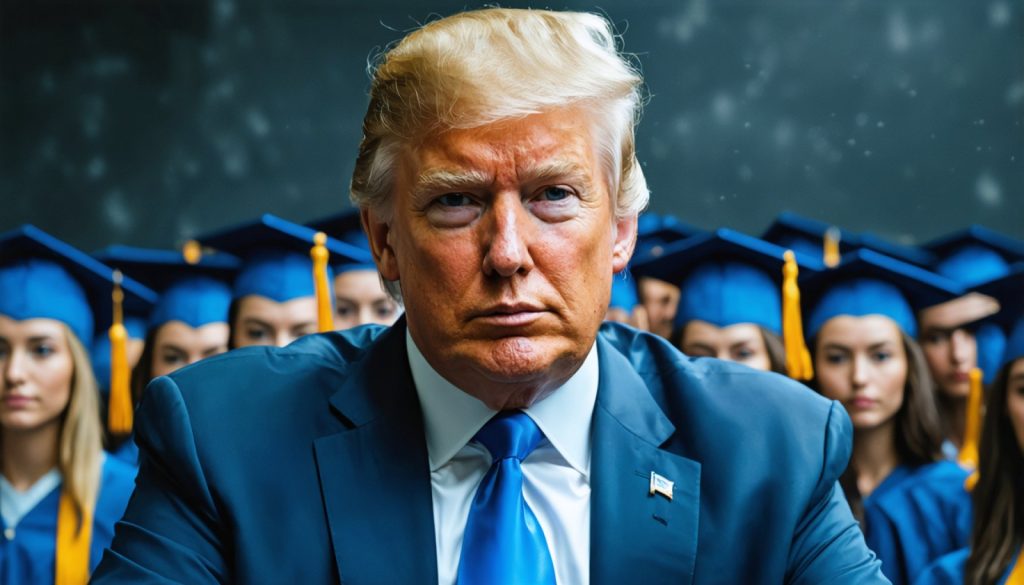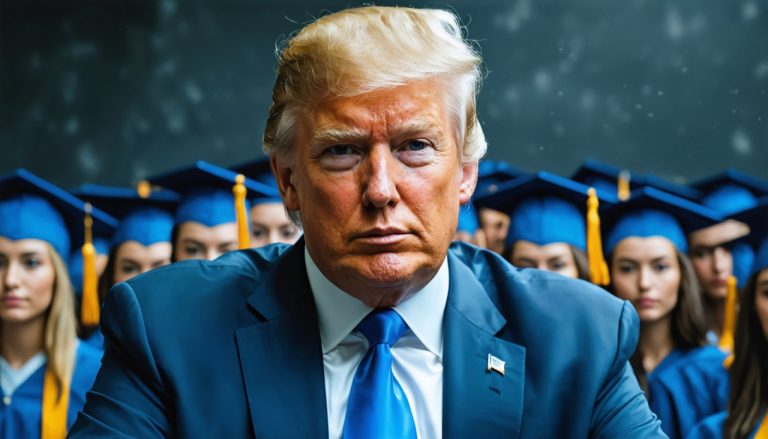
- A landmark executive order by President Trump aims to immerse AI into U.S. education, reshaping it from universities to K-12 schools.
- The Executive Order on Advancing Artificial Intelligence Education establishes a White House Task Force to develop AI-based educational programs.
- Federal grants are set to support AI-driven instructional resources and faculty training, fostering a future-ready workforce.
- Initiatives like the Presidential Artificial Intelligence Challenge encourage students to innovate in fields such as ethics and healthcare.
- The directive stresses workforce readiness through AI apprenticeships and public-private partnerships, ensuring curricula meet evolving job market demands.
- Balancing innovation with equity is crucial; concerns over AI bias necessitate careful human oversight within educational applications.
- Ultimately, the success of this transformation depends on ethical AI integration, ensuring it benefits both intellectual growth and student well-being.
Beneath the dynamic lights of an international summit in Geneva, a robot demonstrates the relentless march of artificial intelligence—a technology poised to redefine countless aspects of modern life. Meanwhile, across the Atlantic on April 23, 2025, President Donald J. Trump signs a landmark executive order aiming to revolutionize higher education. This directive, titled the Executive Order on Advancing Artificial Intelligence Education for American Youth, seeks to catapult the United States to the forefront of the AI revolution by infusing artificial intelligence deeply into the educational fabric, starting from universities to K-12 institutions.
Vivid with purpose, this order does not merely call for iterative enhancements but sets an expansive vision—one that demands the entire U.S. educational system embrace AI literacy and innovation to sculpt a future-leading workforce. It decrees the establishment of a White House Task Force on Artificial Intelligence Education, charging it with embedding AI within educational frameworks and guiding federal agencies to cultivate a new kind of academic ecosystem. The mandate visualizes university campuses evolving into cradles of AI prowess, where disciplines across the board, from computer science to the arts, resonate with the rhythm of groundbreaking AI integration.
Consider Princeton University, amidst current challenges like the recent tragic loss of student Lauren Blackburn. Such institutions face this transformative agenda, potentially marrying innovative AI practices with student welfare in a delicate, yet promising, dance. Federal grant programs are expected to turbocharge this evolution, fortifying AI-based instructional resources, career advising, and crucially, faculty training. This represents a clarion call: for the United States to secure its place as a global AI leader, its youth must be equipped not only with technological skills but with an understanding rooted deeply in critical thinking and ethical perspectives.
Take the Rochester Institute of Technology, an exemplar in weaving AI across various fields. Its faculty recognize AI’s potential to transcend its origins in technology and penetrate disciplines as diverse as business and social sciences. As this vision takes shape, it’s coupled with the Presidential Artificial Intelligence Challenge—an avenue for students to showcase their AI ingenuity, particularly in sensitive areas like ethics and healthcare.
Simultaneously, the Secretary of Education will issue guidance, heralding new interdisciplinary programs forged through AI. Yet, the push for technological adoption is not absent of caution. While AI promises remarkable efficiencies—from personalized student feedback to streamlining administrative duties—the specter of bias looms large. Balancing innovation with equity demands human oversight, an imperative underscored by advocates wary of unbridled AI use in academic admissions potentially mirroring historic prejudices.
On the economic front, the executive order’s focus on workforce readiness signals a thrust towards AI-related apprenticeships and strategic use of Workforce Innovation and Opportunity Act funds. Universities are tasked with establishing robust public-private partnerships, aligning curricula to meet the demands of a rapidly evolving job market.
As criticism and hope intertwine, universities today sit at a pivotal crossroads. The task force, helmed by the Director of the Office of Science and Technology Policy, is poised to drive synergistic collaboration among academia, government, and industry, positioning educational institutions as nuclei of global AI leadership. This initiative envisages a future where students gain cutting-edge skills, faculty access innovative teaching tools, and administrators manage campuses with unprecedented efficiency—all contingent on mindful, equitable execution.
At the heart of this sweeping transformation lies a simple, yet profound proposition: can the integration of AI be both a catalyst for intellectual advancement and a guardian of student well-being? As the Trump administration takes this ambitious leap, success will hinge on navigating the complex terrain of ethical AI integration—ensuring that innovation serves humanity in the truest, most inclusive sense.
The AI Educational Revolution: How Trump’s Executive Order Shapes the Future
The Executive Order: A New Era for AI in Education
President Donald J. Trump’s 2025 executive order on artificial intelligence (AI) in education marks a pivotal moment for the U.S. educational system. By integrating AI into curriculums from K-12 to higher education, this initiative aims to keep the U.S. at the forefront of the global AI revolution. The Executive Order on Advancing Artificial Intelligence Education for American Youth emphasizes AI literacy, ethical understanding, and workforce readiness, setting the stage for a transformative journey.
Key Components of the Executive Order
1. White House Task Force on AI Education: A dedicated body to integrate AI across educational frameworks, supporting federal agencies in cultivating a robust AI ecosystem.
2. Federal Grant Programs: Financial support to enhance AI-based instructional resources, faculty training, and career advising.
3. Presidential Artificial Intelligence Challenge: A platform for students to showcase AI projects, particularly those addressing ethics and healthcare.
4. Interdisciplinary AI Programs: Initiatives led by the Secretary of Education to introduce AI across disciplines, promoting a holistic educational experience.
5. Workforce Readiness Focus: Emphasizing AI-related apprenticeships and strategic use of Workforce Innovation and Opportunity Act funds.
How-To Steps & Life Hacks
– For Educators: Explore emerging AI teaching tools to personalize learning experiences and improve administrative efficiency.
– For Students: Engage in AI competitions and programs to gain hands-on experience and showcase your skills in areas like ethics and healthcare.
– For Parents: Stay informed about the AI tools your child may encounter in education and discuss the ethical implications of technology use.
Real-World Use Cases
– Rochester Institute of Technology: Demonstrating the integration of AI across fields like business and social sciences, RIT is a model for how AI can permeate various disciplines.
– Princeton University: Balancing innovative AI practices with student welfare, Princeton exemplifies the delicate dance of integrating technology with human-centered education.
Market Forecasts & Industry Trends
The global AI in education market is projected to grow significantly, with an increasing number of institutions integrating AI-driven tools for personalized learning, predictive analytics, and administrative tasks. This shift promises to reshape educational landscapes and work environments.
Controversies & Limitations
– Bias Concerns: AI applications in academic admissions may reflect historical prejudices. Human oversight is crucial to ensure equitable outcomes.
– Ethical Challenges: The integration of AI necessitates a strong ethical framework to protect student well-being and privacy.
Pros & Cons Overview
Pros:
– Enhanced personalized learning experiences.
– Improved administrative efficiency.
– Greater readiness for AI-driven job markets.
Cons:
– Potential for bias in AI algorithms.
– Challenges in ensuring ethical use of AI technologies.
Actionable Recommendations
1. Educators: Integrate AI literacy in curricula to prepare students for future job markets.
2. Institutions: Develop public-private partnerships to align educational goals with industry needs.
3. Students: Participate in AI programs and challenges to develop critical skills and knowledge.
By understanding the broader implications of AI integration in education and navigating its challenges, stakeholders can harness technology’s potential to drive intellectual advancement while maintaining ethical standards. The AI revolution in education is not just about technology; it’s about shaping the future workforce and society. For further insights into AI educational advancements, visit the White House website.



